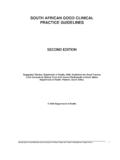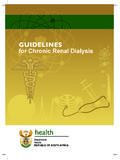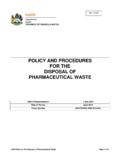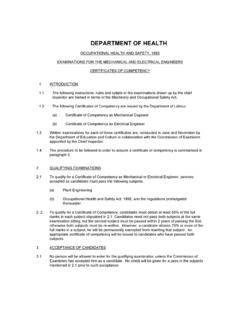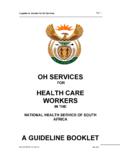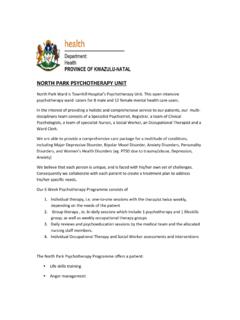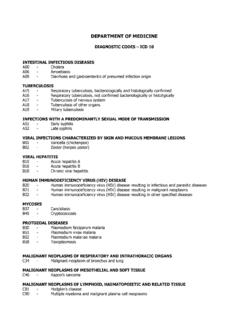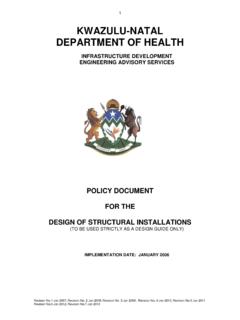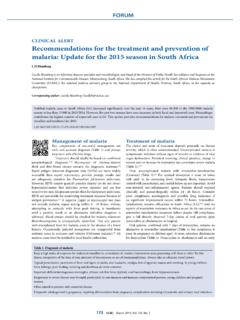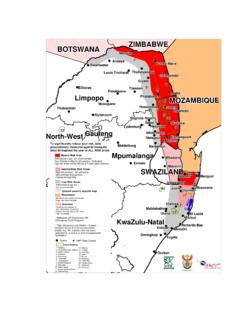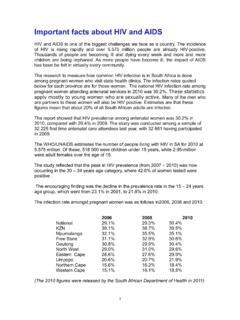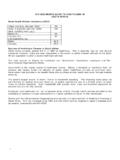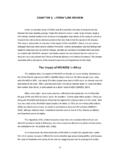Transcription of The South African Antiretrovial Treatment …
1 THE South African ANTIRETROVIRAL Treatment guidelines 2013 VERSION 14 March 2013 The South African Antiretroviral Treatment guidelines 2013 Contents Acronym glossary .. 2 1. Goals of the programme .. 3 2. Objectives .. 3 3. Specific Objectives .. 3 4. Adults and Adolescents .. 4 Standardised national eligibility criteria for starting ART regimens for adults and adolescents .. 4 Standardised national ART regimens for adults and adolescents .. 5 Standardized National Monitoring for Adults and Adolescents with HIV .. 6 Indications for urgent up- referral prior to initiation or when on therapy .. 6 5. Infants and Children .. 7 Standardised national eligibility criteria for starting ART regimens for infants and children.
2 7 Standardised national ART regimens for infants and children .. 7 Standardized national monitoring for infants and children with HIV .. 8 6. HIV- positive Pregnant Women and Newborn Infants .. 10 Standardised national ART and ARV regimens for women who are HIV positive and pregnant and their infants .. 10 7. Special Considerations .. 12 TB Patients .. 12 INH Prophylaxis .. 13 The South African Antiretroviral Treatment guidelines 2013 Acronym glossary 3TC Lamivudine ABC Abacavir aids acquired immune deficiency syndrome ALT Alanine Aminotransferase ART Antiretroviral Treatment ARV Antiretroviral AZT Zidovudine CD4 Cluster of Differentiation 4 D4T Stavudine DNA PCR DNA Polymerase Chain Reaction EFV Efavirenz FBC Full Blood Count FTC Emtricitabine Hb Haemoglobin HepBSAg Hepatitis B Surface Antigen HIV Human Immunodeficiency Virus IPT Isoniazid Preventive Therapy LPV/r Lopinavir/ritonavir MCH Maternal and Child Health MDR/XDR-TB Multi-Drug Resistant / Extensively Drug Resistant Tuberculosis NVP Nevirapine PHC Primary Health Care SRH Sexual and Reproductive Health TB Tuberculosis TDF Tenofovir WHO World Health Organization The South African Antiretroviral Treatment guidelines 2013
3 The South African Antiretroviral Treatment guidelines 2013 1. Goals of the programme a. Save lives and improve the quality of life of people living with HIV b. Achieve best health outcomes in the most cost-efficient manner c. Implement nurse-initiated Treatment d. Decentralise service delivery to PHC facilities e. Integrate services for HIV, TB, MCH, SRH and wellness f. Diagnose HIV earlier g. Prevent HIV disease progression h. Avert aids -related deaths i. Retain patients on lifelong therapy j. Prevent new infections among children, adolescents, and adults k. Mitigate the impact of HIV and aids 2. Objectives a. Ensure timely initiation of ARVs for Treatment and prevention according to the Presidential mandates b. Contribute to strengthening of the public and private health sectors capacity to deliver high quality integrated health and wellness services c. Implement cascade management and continuum of care d.
4 Minimize unnecessary drug toxicities e. Improve clinical outcomes, promote adherence and improved retention of patients in care f. Optimize the benefits of Treatment as prevention by increasing coverage and annual HCT g. Introduce fixed dose combination of highly effective ARV and improve adherence to Treatment , care and support 3. Specific Objectives 1 To prioritise initiation of combination antiretroviral Treatment for: Patients with CD4 counts <350 cells/mm3 or with severe HIV disease (WHO 3 or 4) irrespective of CD4 Patients co-infected with drug sensitive or resistant TB who should be initiated with ART irrespective of CD4 count Pregnant women with CD4 < 350cells/mm3 for lifelong ART and CD4 >350cells/mm3 for prophylaxis Introduce fixed dose combination (FDC) ART for patients initiated with ART for the first time Introduce FDC ART for HIV positive pregnant women irrespective of CD4 count during pregnancy and during the breastfeeding period Phased introduction of FDC to patients with other co-morbidities (diabetes, hypertension and respiratory diseases, including TB) Phased introduction of FDC to patients who require switching due to drugs toxicity or switching from Stavudine (d4T)
5 Based regime Phased introduction of FDC to patients who are stable of ART and VL suppressed 2 To test all HIV exposed children under-five years and treat all those found to be infected with HIV. 3 To standardise first and second line therapy for children, adolescents, and adults in the public and private sector. 4 To move patients currently on Stavudine-containing regimens to Tenofovir-based FDCs, once creatinine clearance has been checked. Stavudine (d4T) to be used only under specific circumstances. 5 To strengthen capacity of nurses to initiate ARVs for Treatment of pregnant women who are HIV positive for their own health and to prevent mother to child transmission. 6 To strengthen PHC facilities to initiate, manage, monitor and refer patients. The South African Antiretroviral Treatment guidelines 2013 4. Adults and Adolescents Standardised national eligibility criteria for starting ART regimens for adults and adolescents Eligible to start ART CD4 count <350 cells/mm3 irrespective of WHO clinical stage OR Irrespective of CD4 count o All types of TB (In patients with TB/HIV drug resistant or sensitive TB, including extra pulmonary TB) o HIV positive women who are pregnant or breast feeding OR Patients with Cryptococcus meningitis or TB meningitis (defer ART for 4-6 weeks) WHO stage 3 or 4 irrespective of CD4 count Require fast track ( ART initiation within 7 days of being eligible)
6 HIV positive women who are pregnant or breast feeding OR Patients with low CD4 <200 OR Patients with Stage 4, irrespective of CD4 count OR Patients with TB/HIV co morbidity with CD4 count < 50 Patients with CD4 above 350, Not yet eligible for ART Transfer to a wellness programme for regular follow-up and repeat CD4 testing 6-monthly. Advise on how to avoid HIV transmission to sexual partners and children Initiate INH prophylaxis if asymptomatic for TB Provide counselling on nutrition and contraceptive and do annual pap smear The South African Antiretroviral Treatment guidelines 2013 Standardised national ART regimens for adults and adolescents 1st Line All new patients needing Treatment , including pregnant women TDF + FTC (or 3TC) +EFV FDC preferred Replace EFV with NVP in patients with significant psychiatric co-morbidity or intolerance to EFV and where the neuro-psychiatric toxicity of EFV may impair daily functioning, shift workers.
7 Contraindications to EFV TDF + (FTC or 3TC) + NVP Use NVP based regimen: In patients with significant psychiatric co morbidity or intolerance to EFV and where the neuro-psychiatric toxicity of EFV may impair daily functioning, shift workers. Contraindication to TDF AZT+ 3TC +EFV or (NVP) Renal disease or the use of other nephrotoxic drugs aminoglycosides Contraindication to TDF and AZT d4T + 3TC+ EFV (or NVP) Renal disease and anaemia or the use of other nephrotoxic drugs, aminoglycosides Contraindication to TDF, AZT and d4T ABC + 3TC + EFV (or NVP) Renal disease, anaemia, peripheral neuropathy, the use of other nephrotoxic drugs Currently on d4T-based regimen TDF + FTC(or 3TC) + EFV FDC preferred Mandatory if patients experience toxicity and patients who are at high risk of toxicity (high BMI or pregnant). Switch to TDF if virally suppressed and the patient has normal creatinine clearance, even if well tolerated.
8 2ndLine Management of virological failure If plasma HIV RNA >1000 copies, Check for adherence, compliance, tolerability and drug- drug interaction and assess psychological issues. Repeat VL test 2 months later. If plasma VL confirmed >1000copies change regime to second line therapy Failing on a TDF-based 1st line regimen AZT+3TC+ LPV/r Patients with anaemia and renal failure switch to ABC Failing on a d4T-based 1st line regimen TDF+3TC (or FTC) and LPV/r Dyslipidaemia or diarrhoea associated with LPV/r Switch LPV/r to ATV/r Third line Failing any 2nd line regimen Specialist referral Should be expert and genotype resistance testing based decision and supervised care Patients failing on second line therapy will be managed by an expert panel. The drugs for third line will be managed centrally. More discussion is required to deal with the modalities Most likely regimen would be Raltegravir/Darunavir/ /Etravirine adjusted according to genotype Interpretation.
9 Should be by expert and take into account prior exposure and predictable mutations The South African Antiretroviral Treatment guidelines 2013 Standardized National Monitoring for Adults and Adolescents with HIV At initial Diagnosis of HIV Purpose Confirm HIV result with rapid antibody test Ensure that national testing algorithm has been followed Do CD4 count if HIV positive and WHO clinical staging To assess eligibility for ART To assess eligibility for fast-tracking Screen for pregnancy or ask if planning to conceive To identify women who need ART for life or ARV prophylaxis for PMTCT (see section 6) Screen for TB symptoms using the WHO questionnaire To identify TB/HIV co-infected Do the CD4 count on the same day To identify eligibility for ART or ARVs for prophylaxis if pregnant Do HB or FBC if requires AZT Creatinine if requires TDF For patients initiated on Nevirapine based regime do ALT To detect anaemia or neutropenia, To detect renal insufficiency To exclude liver disease On ART Purpose CD4 at 1 year on ART To monitor immune response to ART VL at month 6, 1 year on ART and then every 12 months To identify Treatment failures and problems with adherence ALT only if on NVP and develops rash or symptoms of hepatitis To identify NVP toxicity FBC at month 3 and 6 if on AZT To identify AZT toxicity Creatinine at month 3 and 6.
10 1 year then every 12 months if on TDF To identify TDF toxicity Fasting cholesterol and triglycerides at month 3 if on LPV/r To identify LPV/r toxicity At Routine Follow-Up Visits for those not yet eligible for ART Purpose Repeat CD4 count at 6 months To see if they have become eligible for ART WHO clinical staging at every visit To see if they have become eligible for ART Screen for TB symptoms to identify TB suspects Offer IPT if no TB symptoms To identify TB/HIV co-infection To prevent TB activation Offer prevention for HIV positives To prevent HIV transmission and re-infection To prevent STIs Indications for urgent up-referral prior to initiation or when on therapy eGFR less than 60 ml/min Hb less than 8 g/dl BMI less than kg/m2 In a patient with TB, poor response to TB Treatment The South African Antiretroviral Treatment guidelines 2013 5. Infants and Children Standardised national eligibility criteria for starting ART regimens for infants and children Eligible to Start ART All children less than 5 years of age, irrespective of CD4 Children 5 years to 15 years with WHO clinical stage 3 or 4 or CD4 <350 cells/ l Require Fast-Track ( start ART within 7 days of being eligible) Children less than 1 year of age WHO clinical Stage 4 MDR or XDR-TB CD4 Count < 200 cells/ l r < 15% Standardised national ART regimens for infants and children First Line Regimen All infants and children under 3 years (or < 10kg) ABC + 3TC + LPV/r Children 3 years (or 10kg)
